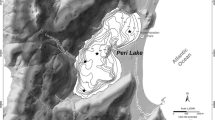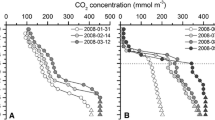Abstract
In this study, we tested the hypothesis that pCO2 and air–water CO2 fluxes in the surface waters of a subtropical lake vary on two time scales (diel and seasonally) and that CO2 concentrations would decrease during the day and in summer. We estimated the variability of pCO2 and the air–water CO2 flux from pH-alkalinity in four 48-h periods that were representative of each subtropical season. There was high variability in pCO2 and the air–water gas flux over 48 h, but there was no clear pattern between day and night. CO2 concentrations showed a strong positive correlation with heterotrophic bacterial biomass and a negative correlation with dissolved organic carbon concentrations and water temperature. The lake was predominantly diel and seasonally CO2 supersaturated; the highest CO2 efflux was observed in the spring and a CO2 influx was observed in summer. Our hypothesis was confirmed; pCO2 was lowest in summer and during the daytime in spring and summer due to physical and biological conditions that favoured photosynthetic activities. These findings suggest that temporal shifts in the microbial community and meteorological variables, which are indirectly related to temperature, may be important drivers of CO2 concentrations in Peri Lake. In conclusion, pCO2 and the air–water CO2 flux vary temporally (diel and seasonally) in the littoral zone of this subtropical coastal lake, with shifts between CO2 influx and efflux throughout the sampling periods.




Similar content being viewed by others
References
Briand JF, Leboulanger C, Humbert JF, Bernard C, Dufour P (2004) Cylindrospermopsis raciborskii (Cyanobacteria) invasion at mid-latitudes: selection, wide physiological tolerance, or global warming? J Phycol 40:231–238
Chonudomkul D, Yongmanitchal W, Theeragool G, Kawachi M, Kasal F, Kaya K, Watanabe M (2004) Morphology, genetic diversity, temperature tolerance and toxicity of Cylindrospermopsis raciborskii (Nostocales, Cyanobacteria) strains from Thailand and Japan. FEMS Microbiol Ecol 48:345–355
Coffin RB, Connolly JP, Harris PS (1993) Availability of dissolved organic-carbon to bacterioplankton examined by oxygen utilization. Mar Ecol Prog Ser 101:9–22. doi:10.3354/meps101009
Cole JJ, Caraco NF (1998) Atmospheric exchange of carbon dioxide in a low-wind oligotrophic lake measured by the addition of SF6. Limnol Oceanogr 43:647–656
Cole JJ, Caraco NF, Kling GW, Kratz TK (1994) Carbon-dioxide supersaturation in the surface waters of lakes. Science 265:1568–1570
Cole JJ, Prairie YT, Caraco NF, McDowell WH, Tranvik LJ, Striegl RG, Duarte CM, Kortelainen P, Downing JA, Middelburg JJ, Melack J (2007) Plumbing the global carbon cycle: integrating inland waters into the terrestrial carbon budget. Ecosystems 10:171–184
Corlett RT (2013) Where are the subtropics? Biotropica 45:273–275
Del Giorgio PA, Cole JJ, Cimbleris A (1997) Respiration rates in bacteria exceed phytoplankton production in unproductive aquatic systems. Nature 385:148–151
Duarte CM, Prairie YT (2005) Prevalence of heterotropy and atmospheric CO2 emissions from aquatic ecosystems. Ecosystems 8:862–870
Fan C, Hu W, Ford P, Chen Y, Qu W, Zhang L (2005) Carbon dioxide partial pressure and carbon fluxes of air-water interface in Taihu Lake, China. Chin J Oceanol Limnol 23:29–38
Fontes MLS, Abreu P (2009) Spatio-temporal variation of bacterial assemblages in a shallow subtropical coastal lagoon in Southern Brazil. Microb Ecol 58:140–152
Fontes MLS, Tonetta D, Dalpaz L, Antônio RV, Petrucio MM (2013) Dynamics of planktonic prokaryotes and dissolved carbon in a subtropical coastal lake. Frontiers Microbiol. doi:10.3389/fmicb.2013.00071
Fontes MLS, Marotta H, MacIntyre S, Petrucio MM (2015) Inter- and intra-annual variations of pCO2 and pO2 in a freshwater subtropical coastal lake. Inland Waters 5:107–116
Golterman HL, Clymo RS, Ohnstad MAM (1978) Methods for physical and chemical analysis of freshwater. Blackwell Science, Oxford
Hennemann MC, Petrucio MM (2011) Spatial and temporal dynamic of trophic relevant parameters in a subtropical coastal lagoon in Brazil. Environ Monit Assess 181:347–361
Jiang Y, Hu Y, Schirmer M (2013) Biogeochemical controls on daily cycling of hydrochemistry and δ13C of dissolved inorganic carbon in a karst spring-fed pool. J Hydrol 478:157–168
Koroleff F (1976) Determination of nutrients. In: Grasshoff K (ed) Methods of sea water analysis. Verlag Chemie Weinhein, pp 117–181
Kosten S, Roland F, Motta Marques DML, Van Nes EH, Mazzeo N, Sternberg LSL, Scheffer M, Cole JJ (2010) Climate-dependent CO2 emissions from lakes. Global Biogeochem Cycles 24:GB2007
Lorenzen CJ (1967) Determination of chlorophyll and pheopigments: spectrophotometric equations. Limnol Oceanogr 12:343–346
Maberly SC, Barker PA, Stott AW, De Ville MM (2012) Catchment productivity controls CO2 emissions from lakes. Nature Climate Change 3:391–394
MacIntyre S, Jonsson A, Jansson M, Aberg J, Turney DE, Miller SD (2010) Buoyancy flux, turbulence, and the gas transfer coefficient in a stratified lake. Geophys Res Lett 37:L24604
Mackereth FJH, Heron JE, Talling JF (1978) Water analysis: some revised methods for limnologists. Freshw Biol Assoc
Marotta H, Duarte CM, Sobek S, Enrich-Prast A (2009a) Large CO2 disequilibria in tropical lakes. Global Biogeochem Cycles 23:GB4022
Marotta H, Paiva LP, Petrucio MM (2009b) Changes in thermal and oxygen stratification pattern coupled to CO2 outgassing persistence in two oligotrophic shallow lakes of the Atlantic tropical forest, southeast Brazil. Limnology 10:195–202
Marotta H, Duarte CM, Pinho L, Enrich-Prast A (2010) Rainfall leads to increased pCO2 in Brazilian coastal lakes. Biogeosciences 7:1607–1614
Marotta H, Ricci RMP, Sampaio PL, Melo PP, Enrich-Prast A (2012a) Variações em curto prazo do metabolismo e da pCO2 na lagoa Rodrigo de Freitas: elevado dinamismo em um ecossistema tropical urbano. Oecol Aust 16:391–407
Marotta H, Fontes MLS, Petrucio MM (2012b) Natural events of anoxia and low respiration index in oligotrophic lakes of the Atlantic Tropical Forest. Biogeosciences 9:4225–4244
Marotta H, Pinho L, Gudasz C, Bastviken D, Tranvik LJ, Enrich-Prast A (2014) Greenhouse gas production in low-latitude lake sediments responds strongly to warming. Nature Climate Change. doi:10.1038/nclimate2222
Massana R, Gasol JM, Bjornsen PK, Blackburn N, Hagstrom A, Hietanen S, Hygum BH, Kuparinen J, Pedrós-Alió C (1997) Measurement of bacterial size via image analysis of epifluorescence preparations: description of an inexpensive system and solutions to some of the most common problems. Scientia Marina 61:397–407
Nimick DA, Gammons CH, Parker SR (2011) Diel biogeochemical processes and their effect on the aqueous chemistry of streams: a review. Chem Geol 283:3–17
Norland S (1993) The relationship between biomass and volume of bacteria. In: Kemp PF, Sherr BF, Sherr EB, Cole JJ (eds) Handbook of methods in aquatic microbial ecology. Lewis pp 303–307
Pacheco FS, Roland F, Downing JA (2013) Eutrophication reverses whole-lake carbon budgets. Inland Waters 4:41–48
Panzenbock M (2007) Effect of solar radiation on photosynthetic extracellular carbon release and its microbial utilization in alpine and Arctic lakes. Aquat Microb Ecol 48:155–168
Petrucio MM, Barbosa FAR (2004) Diel variations of phytoplankton and bacterioplankton production rates in four tropical lakes in the middle Rio Doce basin (southeastern Brazil). Hydrobiologia 513:71–76
Pinardi M, Rosseto M, Viaroli P, Bartoli M (2014) Daily and seasonal variability of CO2 saturation and evasion in a free flowing and in a dammed river reach. J Limnol 73:468–481
Porter KG, Feig YS (1980) The use of DAPI for identifying and counting aquatic microflora. Limnol Oceanogr 25:943–948
Raymond PA, Hartmann J, Lauerwald R et al (2013) Global carbon dioxide emissions from inland waters. Nature 503:355–359
Read JS, Hamilton DP, Desai AR, Rose KC, MacIntyre S, Lenters JD, Smyth RL, Hanson PC, Cole JJ, Staehr PA, Rusak JA, Pierson DC, Brookes JD, Laas A, Wu CH (2012) Lake-size dependency of wind shear and convection as controls on gas exchange. Geophys Res Lett 39:L09405
Sobek S, Tranvik L, Cole, JJ (2005) Temperature independence of carbon dioxide supersaturation in global lakes. Global Biogeochem Cycles 19:GB2003. doi:10.1029/2004GB002264
Sadro S, Nelson CE, Melack JM (2011) Linking diel patterns in community respiration to bacteriplankton in an oligotrophic high-elevation lake. Limnol Oceanogr 56:540–550
Sejr MK, Krause-Jensen D, Dalsgaard T, Ruiz-Halpern S, Duarte CM, Middelboe M, Glud RN, Bendtsen J, Balsby TJS, Rysgaard S (2014) Seasonal dynamics of autotrophic and heterotrophic plankton metabolism and PCO2 in a subarctic Greenland fjord. Limnol Oceanogr 59:1764–1778
Snoeyink VL, Jenkins D (1980) Water chemistry. Wiley, New York
Staehr PA, Sand-Jensen K (2007) Temporal dynamics and regulation of lake metabolism. Limnol Oceanogr 52:108–120
Strickland JDH, Parsons TR (1960) A manual of seawater analysis. Bulletin 125:1–18
Stumm W, Morgan JJ (1996) Aquatic chemistry: Chemical equilibria and rates in natural waters. Wiley, New York
Tans P (2013) National oceanic and atmospheric administration. http://www.esrl.noaa.gov/gmd/ccgg/trends/. Accessed 20 August 2013
Tonetta D, Petrucio MM, Laudares-Silva R (2013) Temporal variation in phytoplankton community in a freshwater coastal lake of southern Brazil. Acta Limnol Bras 25:99–110
Tonetta D, Laudares-Silva R, Petrucio MM (2015) Planktonic production and respiration in a subtropical lake dominated by cyanobacteria. Braz J Biol (in press)
Tranvik LJ, Downing JA, Cotner JB et al (2009) Lakes and reservoirs as regulators of carbon cycling and climate. Limnol Oceanogr 54:2298–2314
Trolle D, Staehr PA, Davidson TA, Bjerring R, Lauridsen TL, Søndergaard M, Jeppesen E (2012) Seasonal dynamics of CO2 flux across the surface of shallow temperate lakes. Ecosystems 15:336–347
Vachon D, Prairie YT (2013) The ecosystem size and shape dependence of gas transfer velocity versus wind speed relationships in lakes. Can J Fish Aquat Sci 70:1757–1764
Vera C, Higgins W, Amador J et al (2006) Toward a unified view of the American monsoon systems. J Clim 19:4977–5000
Wanninkhof R, Knox M (1996) Chemical enhancement of CO2 exchange in natural waters. Limnol Oceanogr 41:689–697
Weiss RF (1974) Carbon dioxide in water and seawater: the solubility of a non-ideal gas. Mar Chem 2:203–215
Xing YP, Xie P, Yang H, Ni LY, Wang YS, Rong KW (2005) Methane and carbon dioxide fluxes from a shallow hypereutrophic subtropical lake in China. Atmos Environ 39:5532–5540
Acknowledgments
We thank all of the reviewers whose suggestions greatly improved this manuscript. We also would like to thank Alex Pires De Oliveira Nuñer (LAPAD—UFSC) and Danilo Funke (FLORAM—Parque Municipal da Lagoa do Peri) for provision of lab and field equipment and the PPGECO—UFSC (Programa de Pós-graduação em Ecologia). This study was funded by CNPq—Brazil (Conselho Nacional de Desenvolvimento Científico e Tecnológico; Universal Process: 473572/2008-7) and CAPES (Coordenação de Aperfeiçoamento de Pessoal de Nível Superior).
Author information
Authors and Affiliations
Corresponding author
Additional information
Handling editor: Ayato Kohzu.
Electronic supplementary material
Below is the link to the electronic supplementary material.
Rights and permissions
About this article
Cite this article
Tonetta, D., Fontes, M.L.S. & Petrucio, M.M. Linking summer conditions to CO2 undersaturation and CO2 influx in a subtropical coastal lake. Limnology 16, 193–201 (2015). https://doi.org/10.1007/s10201-015-0460-9
Received:
Accepted:
Published:
Issue Date:
DOI: https://doi.org/10.1007/s10201-015-0460-9




